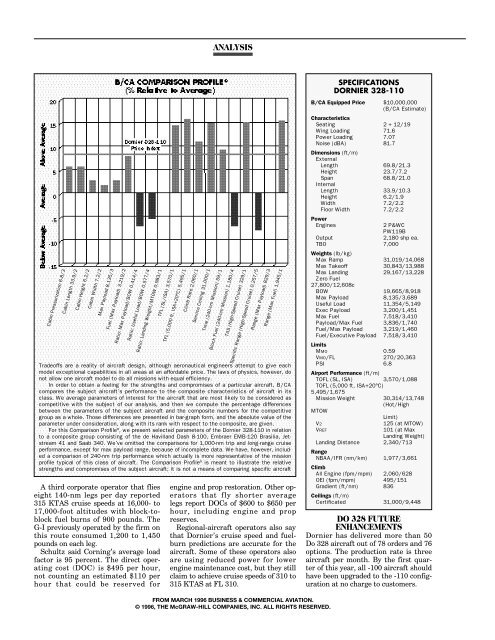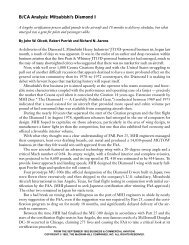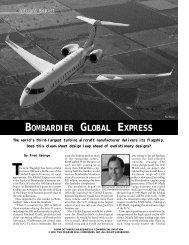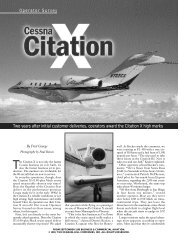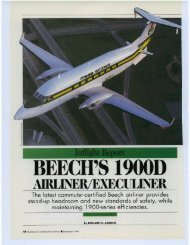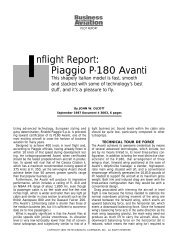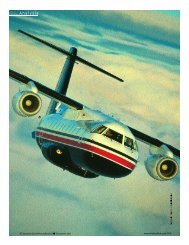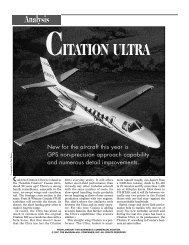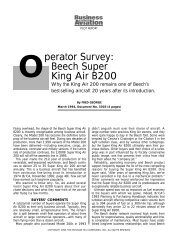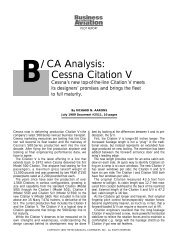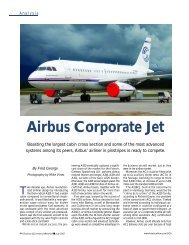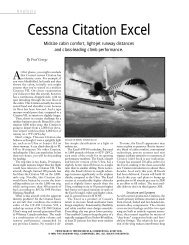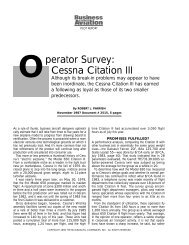Dornier 328 Corporate Shuttle
Dornier 328 Corporate Shuttle
Dornier 328 Corporate Shuttle
You also want an ePaper? Increase the reach of your titles
YUMPU automatically turns print PDFs into web optimized ePapers that Google loves.
ANALYSIS<br />
Cabin Pressurization 6.8/3<br />
Cabin Length 33.9/2<br />
Cabin Height 6.2/2<br />
Cabin Width 7.2/2<br />
Max Payload 8,135/3<br />
Fuel (Max Payload) 3,219/2<br />
Ratio: Max Payload/BOW 0.414/4<br />
Ratio: Useful Load/BOW 0.577/4<br />
Ratio: Landing Weight/MTOW 0.983/1<br />
TFL (SL/ISA) 3,570/1<br />
TFL (5,000 ft, ISA+20°C) 5,495/1<br />
Climb Rate 2,060/1<br />
Service Ceiling 31,000/1<br />
Time (240-nm Mission) 59/1<br />
Block Fuel (240-nm Mission) 1,180/4<br />
TAS (High-Speed Cruise) 329/1<br />
Specific Range (High-Speed Cruise) 0.257/5<br />
Range (Max Payload) 829/3<br />
Range (Max Fuel) 1,945/1<br />
Tradeoffs are a reality of aircraft design, although aeronautical engineers attempt to give each<br />
model exceptional capabilities in all areas at an affordable price. The laws of physics, however, do<br />
not allow one aircraft model to do all missions with equal efficiency.<br />
In order to obtain a feeling for the strengths and compromises of a particular aircraft, B/CA<br />
compares the subject aircraft’s performance to the composite characteristics of aircraft in its<br />
class. We average parameters of interest for the aircraft that are most likely to be considered as<br />
competitive with the subject of our analysis, and then we compute the percentage differences<br />
between the parameters of the subject aircraft and the composite numbers for the competitive<br />
group as a whole. Those differences are presented in bar-graph form, and the absolute value of the<br />
parameter under consideration, along with its rank with respect to the composite, are given.<br />
For this Comparison Profile ® , we present selected parameters of the <strong>Dornier</strong> <strong>328</strong>-110 in relation<br />
to a composite group consisting of the de Havilland Dash 8-100, Embraer EMB-120 Brasilia, Jetstream<br />
41 and Saab 340. We’ve omitted the comparisons for 1,000-nm trip and long-range cruise<br />
performance, except for max payload range, because of incomplete data. We have, however, included<br />
a comparison of 240-nm trip performance which actually is more representative of the mission<br />
profile typical of this class of aircraft. The Comparison Profile ® is meant to illustrate the relative<br />
strengths and compromises of the subject aircraft; it is not a means of comparing specific aircraft<br />
A third corporate operator that flies<br />
eight 140-nm legs per day reported<br />
315 KTAS cruise speeds at 16,000- to<br />
17,000-foot altitudes with block-toblock<br />
fuel burns of 900 pounds. The<br />
G-I previously operated by the firm on<br />
this route consumed 1,200 to 1,450<br />
pounds on each leg.<br />
Schultz said Corning’s average load<br />
factor is 95 percent. The direct operating<br />
cost (DOC) is $495 per hour,<br />
not counting an estimated $110 per<br />
hour that could be reserved for<br />
engine and prop restoration. Other operators<br />
that fly shorter average<br />
legs report DOCs of $600 to $650 per<br />
hour, including engine and prop<br />
reserves.<br />
Regional-aircraft operators also say<br />
that <strong>Dornier</strong>’s cruise speed and fuelburn<br />
predictions are accurate for the<br />
aircraft. Some of these operators also<br />
are using reduced power for lower<br />
engine maintenance cost, but they still<br />
claim to achieve cruise speeds of 310 to<br />
315 KTAS at FL 310.<br />
SPECIFICATIONS<br />
DORNIER <strong>328</strong>-110<br />
B/CA Equipped Price $10,000,000<br />
(B/CA Estimate)<br />
Characteristics<br />
Seating 2 + 12/19<br />
Wing Loading 71.6<br />
Power Loading 7.07<br />
Noise (dBA) 81.7<br />
Dimensions (ft/m)<br />
External<br />
Length 69.8/21.3<br />
Height 23.7/7.2<br />
Span 68.8/21.0<br />
Internal<br />
Length 33.9/10.3<br />
Height 6.2/1.9<br />
Width 7.2/2.2<br />
Floor Width 7.2/2.2<br />
Power<br />
Engines<br />
2 P&WC<br />
PW119B<br />
Output<br />
2,180 shp ea.<br />
TBO 7,000<br />
Weights (lb/kg)<br />
Max Ramp 31,019/14,068<br />
Max Takeoff 30,843/13,988<br />
Max Landing 29,167/13,228<br />
Zero Fuel<br />
27,800/12,608c<br />
BOW 19,665/8,918<br />
Max Payload 8,135/3,689<br />
Useful Load 11,354/5,149<br />
Exec Payload 3,200/1,451<br />
Max Fuel 7,518/3,410<br />
Payload/Max Fuel 3,836/1,740<br />
Fuel/Max Payload 3,219/1,460<br />
Fuel/Executive Payload 7,518/3,410<br />
Limits<br />
MMO 0.59<br />
VMO/FL 270/20,363<br />
PSI 6.8<br />
Airport Performance (ft/m)<br />
TOFL (SL, ISA) 3,570/1,088<br />
TOFL (5,000 ft, ISA+20°C)<br />
5,495/1,675<br />
Mission Weight 30,314/13,748<br />
(Hot/High<br />
MTOW<br />
Limit)<br />
V2<br />
VREF<br />
125 (at MTOW)<br />
101 (at Max<br />
Landing Weight)<br />
Landing Distance 2,340/713<br />
Range<br />
NBAA/IFR (nm/km) 1,977/3,661<br />
Climb<br />
All Engine (fpm/mpm) 2,060/628<br />
OEI (fpm/mpm) 495/151<br />
Gradient (ft/nm) 836<br />
Ceilings (ft/m)<br />
Certificated 31,000/9,448<br />
DO <strong>328</strong> FUTURE<br />
ENHANCEMENTS<br />
<strong>Dornier</strong> has delivered more than 50<br />
Do <strong>328</strong> aircraft out of 78 orders and 76<br />
options. The production rate is three<br />
aircraft per month. By the first quarter<br />
of this year, all -100 aircraft should<br />
have been upgraded to the -110 configuration<br />
at no charge to customers.<br />
FROM MARCH 1996 BUSINESS & COMMERCIAL AVIATION.<br />
© 1996, THE McGRAW-HILL COMPANIES, INC. ALL RIGHTS RESERVED.


